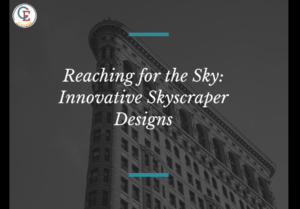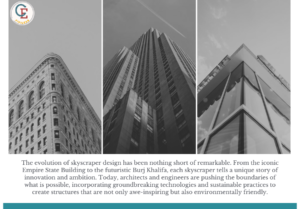Imagine a really tall building, so tall that it seems to touch the sky. That’s what we call a skyscraper. It’s like a giant tower made of steel, glass, and concrete that reaches way up into the clouds. Innovative Skyscraper Designs stand in big cities and they’re super important because they give us space to work, live, and play without taking up too much space on the ground. They’re like modern-day castles of the city, but instead of kings and queens living inside, it’s regular people like you and me. So, next time you’re in a city, look up and see if you can spot one of these amazing skyscrapers towering above you!
In the heart of bustling cities around the world, something extraordinary is happening. Towering skyscrapers, those magnificent giants of steel and glass, are not just reaching for the clouds anymore; they’re pushing the boundaries of architecture and engineering to new heights. Welcome to the captivating world of innovative skyscraper designs, where creativity meets practicality, and dreams touch the sky.
The evolution of skyscraper design has been nothing short of remarkable. From the iconic Empire State Building to the futuristic Burj Khalifa, each skyscraper tells a unique story of innovation and ambition. Today, architects and engineers are pushing the boundaries of what is possible, incorporating groundbreaking technologies and sustainable practices to create structures that are not only awe-inspiring but also environmentally friendly.
One of the most exciting trends in skyscraper design is the integration of green technology. With concerns about climate change growing, architects and engineers are exploring ways to make skyscrapers more energy-efficient and sustainable. From incorporating solar panels and wind turbines to designing green spaces and utilizing recycled materials, these eco-friendly skyscrapers are setting new standards for environmental responsibility.
Another trend gaining traction in skyscraper design is the use of advanced materials and construction techniques. Innovations in materials science have paved the way for stronger, lighter, and more flexible building materials, allowing architects to create daring designs that were once deemed impossible. From carbon fiber composites to self-healing concrete, these cutting-edge materials are revolutionizing the way skyscrapers are built, enabling architects to push the limits of creativity and imagination.
Innovative Skyscraper Designs
Building a skyscraper is like putting together a giant puzzle, but instead of puzzle pieces, we use materials like steel, concrete, and glass. First, we dig deep into the ground to create a strong foundation, like the roots of a tree holding it up. Then, we build a sturdy frame using steel beams and columns, kind of like the skeleton of the building.
Once the frame is up, we add walls and floors made of concrete and glass to create the rooms where people will live and work. Along the way, we use cranes to lift heavy materials up high, like giant toys in a construction playground. It takes a lot of planning, teamwork, and patience, but eventually, all the pieces come together to create a magnificent skyscraper that reaches up into the sky!
How Skyscrapers build let’s break it down into simple steps:
Planning: Engineers and architects come up with a design for the skyscraper, deciding how tall it will be, what it will look like, and what materials will be used.
Preparation: Workers dig deep into the ground to create a strong foundation. This foundation needs to be able to support the weight of the entire building, kind of like the roots of a tree holding it steady.
Frame Construction: Steel beams and columns are put together to form a strong frame, like the skeleton of the building. This frame will support the weight of the building and keep it standing tall.
Floor by Floor: Workers start building each floor one by one, using concrete and steel. They add walls, floors, and ceilings to create the rooms where people will live and work.
Windows and Facade: Glass panels are installed to create windows, allowing light to come in and people to see out. The outside of the building, called the facade, is also put together, giving the skyscraper its unique look.
Finishing Touches: Once the structure is complete, workers add finishing touches like paint, lighting, and interior decorations to make the building look nice and inviting.
Safety Checks: Engineers and inspectors make sure everything is safe and up to code before the building can be used. They check for things like stability, fire safety, and electrical systems.
Opening Day: Finally, after lots of hard work and careful planning, the skyscraper is ready to be used! People move in, businesses open their doors, and the city gains a new landmark to admire.
How Skyscrapers Define Our Cities
Have you ever looked up at a city skyline and felt a sense of wonder? Skyscrapers are more than just buildings; they’re symbols of human achievement and progress. From the iconic Empire State Building in New York City to the breathtaking Burj Khalifa in Dubai, each skyscraper tells a story of ambition and innovation. But what makes these towering structures so special?
Skyscrapers are marvels of engineering, designed to defy gravity and withstand the forces of nature. They rise above the hustle and bustle of city life, offering breathtaking views and a sense of awe to all who behold them. But behind their stunning facades lies a world of intricate design and meticulous planning.
The Latest Trends in Skyscraper Design
In recent years, architects and engineers have been pushing the boundaries of what is possible with skyscraper design. One of the most exciting trends is the incorporation of green technology. With concerns about climate change on the rise, architects are finding innovative ways to make skyscrapers more environmentally friendly. From green roofs and solar panels to energy-efficient facades, these eco-friendly features not only reduce carbon emissions but also lower operating costs for building owners.
Another trend gaining popularity is the use of advanced materials and construction techniques. Innovations in materials science have led to the development of stronger, lighter, and more durable building materials, allowing architects to create daring designs that were once thought impossible. From carbon fiber composites to self-healing concrete, these cutting-edge materials are revolutionizing the way skyscrapers are built, making them safer, more resilient, and more sustainable.
The Rise of Vertical Villages
But skyscrapers are more than just office buildings or residential towers; they’re vertical communities where people live, work, and play. In recent years, there has been a growing trend towards mixed-use developments that combine residential, commercial, and recreational spaces within the same building. These vertical villages offer a host of amenities, including parks, schools, shopping centers, and even sports facilities, creating vibrant urban environments where people can live, work, and socialize without ever having to leave the building.
Engineering Skyscrapers for the Future
Of course, building skyscrapers is not without its challenges. Engineers must contend with a host of factors, including wind forces, seismic activity, and even human behavior. But thanks to advancements in computer modeling and simulation, engineers can now anticipate and address these challenges more effectively than ever before. From wind tunnel testing to seismic analysis, these tools allow engineers to optimize the design of skyscrapers, ensuring they are safe, stable, and resilient in the face of whatever the future may hold.
What’s Next for Skyscraper Design?
As we look to the future, the possibilities for skyscraper design are truly limitless. From vertical farming and 3D-printed buildings to underwater skyscrapers and space elevators, architects and engineers are constantly pushing the boundaries of what is possible. But one thing is for certain: skyscrapers will continue to captivate our imaginations and inspire awe for generations to come.
In conclusion, innovative skyscraper designs are not just reshaping our cities; they’re reshaping the way we think about architecture and engineering. With their stunning designs, eco-friendly features, and vibrant communities, skyscrapers are pushing the boundaries of what is possible and inspiring us to reach for the sky. So the next time you look up at a city skyline, take a moment to marvel at the towering skyscrapers that define our urban landscapes and imagine the endless possibilities that lie ahead.
In addition to technological advancements, social and cultural factors are also shaping the design of modern skyscrapers. As cities become more densely populated, architects are reimagining skyscrapers as vertical communities, incorporating amenities such as schools, parks, and community centers to foster a sense of belonging and connection among residents. This trend towards mixed-use developments not only maximizes the use of limited urban space but also promotes a more sustainable and inclusive urban environment.
Feel free to follow us there on Instagram and drop a comment to say hello!



